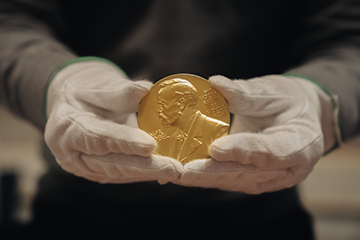![]()
L’Huillier, Agostini and Krausz.
The Royal Swedish Academy of Sciences has awarded the 2023 Nobel Prize in Physics to Optica Fellows Anne L’Huillier (Lund University, Sweden), Pierre Agostini (Ohio State University, USA) and Ferenc Krausz (Max Planck Institute of Quantum Optics and Ludwig-Maximilians-Universität München, Germany).
The trio was honored “for experimental methods that generate attosecond pulses of light for the study of electron dynamics in matter.” As the citation implies, the work of these three pioneers, and others, has fostered the creation of an entirely new discipline—attochemistry—with significant fundamental and practical implications.
From femto to atto
In 1999, Ahmed H. Zewail received the Nobel Prize in Chemistry for his use of femtosecond laser spectroscopy to study chemical reactions, which gave rise to so-called femtochemistry. But even a femtosecond—a millionth of a billionth of a second—looks like an eternity to an electron, which prefers to do its work on the scale of attoseconds, or a billionth of a billionth of a second. How could one get to such unspeakably short timescales?
Anne L’Huillier, one of the three laureates, and others started investigating the question in the 1980s, in research conducted in Paris-Saclay in France. They focused in particular on high-harmonic generation (HHG)—the creation of “overtones” in light, at integer multiples of the laser frequency, when certain gases are exposed to high-intensity infrared laser light.
Early experiments revealed that a large swath of high harmonics could be produced, at a plateau of emission intensities across multiple harmonics. That was sufficient bandwidth to potentially use the high harmonics to create ultrashort pulses—given some understanding of the mechanisms at work.

[Image: © Nobel Prize Outreach. Photo: Clément Morin]
A few years later, in 1991, L’Huillier, along with colleagues Kenneth Schafer and Kenneth Kulander, provided such an understanding in a landmark numerical study. This was followed up by additional work by Kulander, L’Huillier and another key pioneer of strong-field physics, Optica Fellow Paul Corkum of the University of Ottawa, Canada, among others, to build semiclassical and quantum models of the processes at work.
Short pulses, giant steps
This experimental and theoretical background teed up the possibility of generating actual pulses at the attosecond scale. Here, the two other 2023 Physics Laureates, Pierre Agostini and Ferenc Krausz, took the next giant steps toward extremely short pulses.
Agostini developed a technique called reconstruction of attosecond beating by interference of two-photon transitions—nicknamed the RABBIT technique. The principle of the technique involves using the photoelectrons emanating from the laser-gas interaction as a yardstick for pulse width, making it possible to potentially measure attosecond pulses. Krausz’s Vienna-based team, working with the research group of Optica Fellow Mauro Nisoli in Milan, used laser interactions with hollow fiber cores filled with argon or krypton gas to create pulses of less than 5 fs—the shortest pulses ever produced up to that time.
Then, in 1991, the different researchers independently crossed the attosecond threshold. In Paris-Saclay, Agostini’s research group, using the RABBIT technique, demonstrated a train of pulses generated via HHG with widths of only 250 attoseconds each. Krausz’s group in Vienna, meanwhile, employed spectral filtering (via a multilayer XUV mirror) to produce isolated pulses with a width of 650 attoseconds, via a process called streaking.
“Talking to electrons”
These experiments opened the door to a world of possibilities in studying dynamics at the attosecond scale, where electrons like to play.
These experiments opened the door to a world of possibilities in studying dynamics at the attosecond scale, where electrons like to play.
Krausz’s team quickly jumped on those possibilities with measurements in 2010 of the incredibly short (20-attosecond) time delays between the movements of photoemissions of electrons in different orbitals. Initially the work ran into theoretical objections, but subsequent work by L’Huillier’s group, published in 2017, provided measurements in better agreement with theory. Together, these studies provided a window into processes that had previously been outside of the realm of experiment.
Researchers are just beginning to exploit their new, privileged access to electronic processes (see “The Birth of Attochemistry,” OPN, July/August 2019). In addition to fundamental research on how electrons kick off and affect chemical reactions, and practical value in areas such as ultrafast electronics and imaging for semiconductor manufacture, there is even the possibility of using attosecond light as a control knob to shape, speed up and change chemical processes.
“This radiation is ‘talking’ to electrons,” L’Huillier, reached on the phone, said during the press conference announcing the 2023 prize. “When you have a chemical reaction that is induced by the absorption of light … this is always started by some electron transition.”
“So the dream, the ‘holy grail’,” L’Huillier suggested, “is to be able to control this initial time for a molecular reaction. And if you can do that, maybe you can control some reactions and have more insight into the process.”
“It takes time”
During her time on the line, L’Huillier—one of only a handful of women who have won the Nobel Prize in Physics—noted that she had not been able to accept the initial call from Hans Ellegren, the secretary general of the Royal Swedish Academy, because she was busy teaching a class. After finally taking the call, she said, “the last half hour of my lecture was difficult to do”—but she managed.
L’Huillier also touched on how the work recognized in the Nobel Prize underscores the importance of fundamental research—at a time of considerable pressure for scientists to focus on work with immediate practical rewards. “We have been working in this space for 30 years,” she said, “and only now you begin to have applications in sight … It takes time.”
